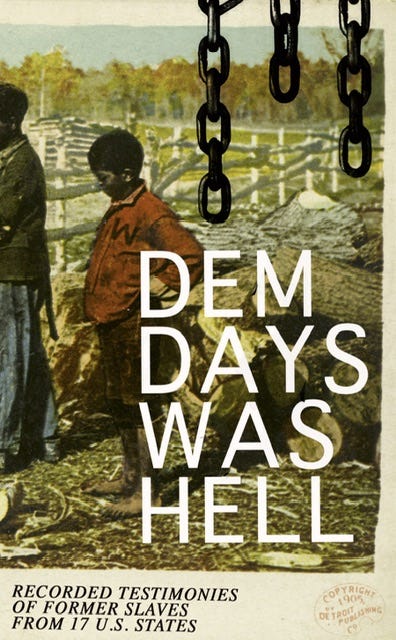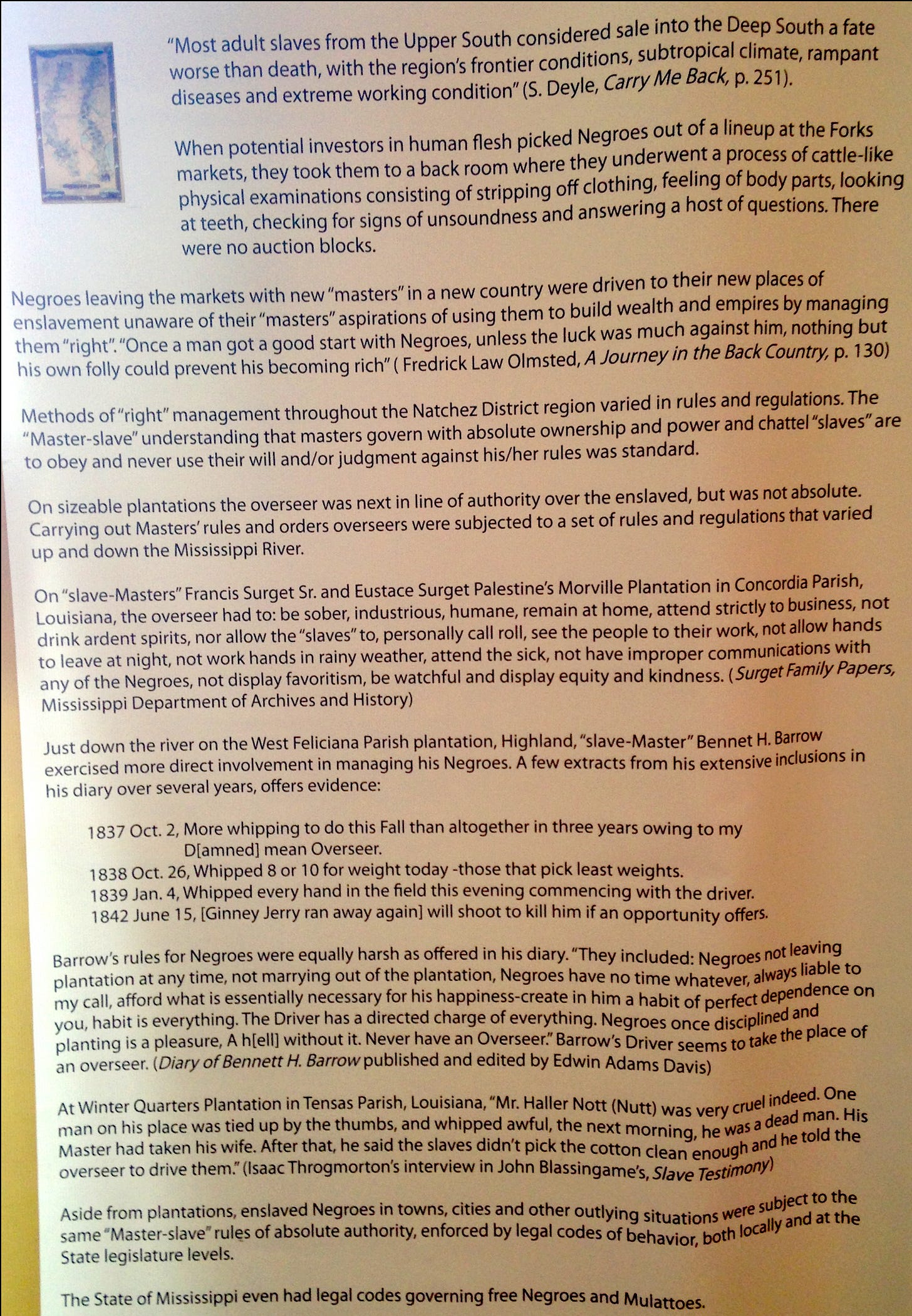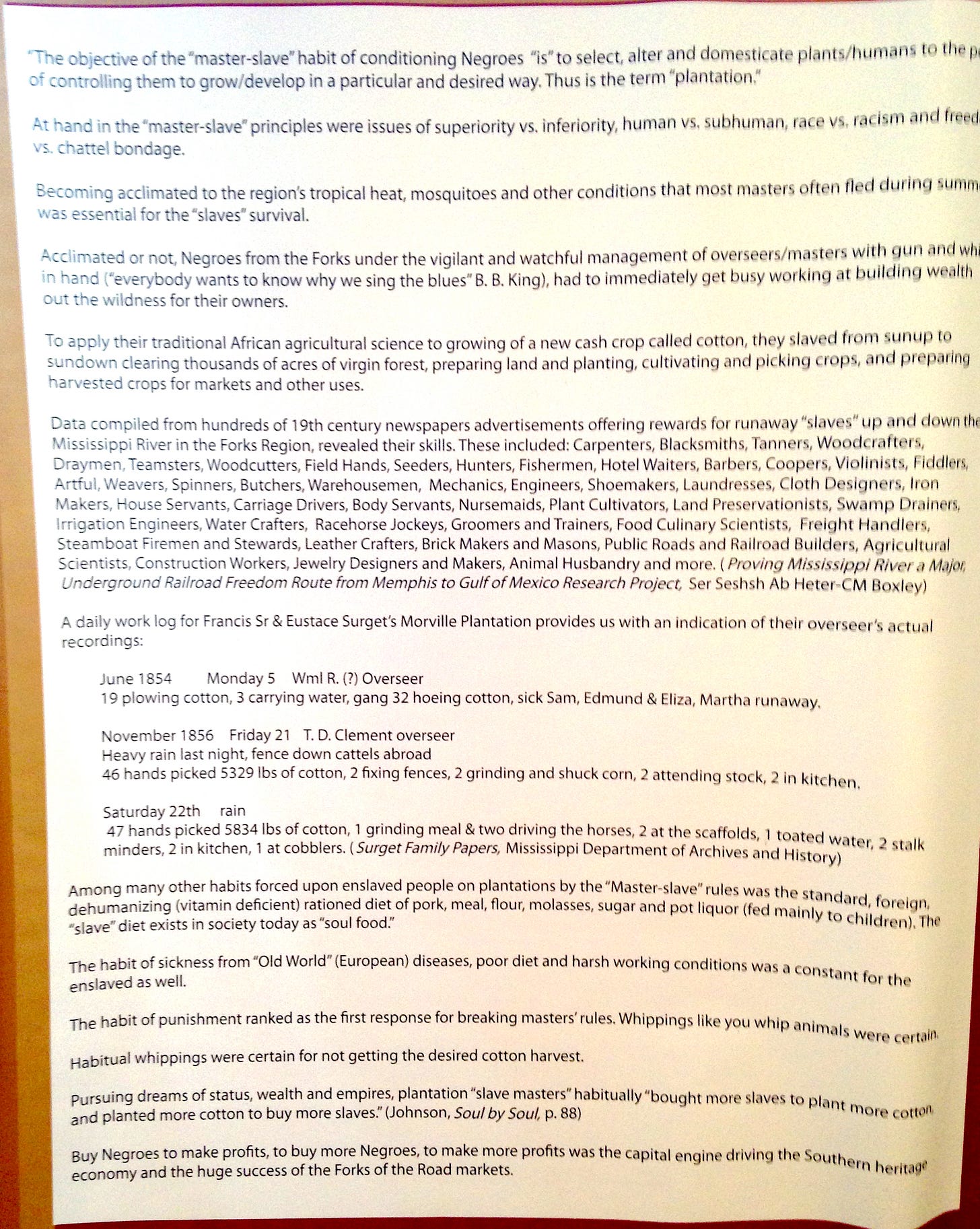The Incredible Journey A Mixed-Race American Child Took To Learn His Family’s History
August 9, 2024 Natchez, Mississippi Visitor Center and the Forks in the Road (Slave Market at Natchez, Mississippi) Part 1
Before traveling to Abbeville, Louisiana, to find my great-great grandfather’s birthplace and plantation location, I made a visit to the Visitor Center in Natchez, Mississippi, and the “Forks of the Road.” The next two posts will provide background information about the life of enslaved people. Natchez was a major hub in the slave trade, and the visitor’s center had extensive displays and information concerning America’s original sin. I’ve included some of that information here. Along with photos of some of the information displays (which were on canvas and not plywood/poster board ), I’ve included wording of the displays for easier reading.
As you read about slavery click the link within the text to learn about “Abdul Rahman Ibrahim Ibn Sori, [he] was West African royalty before he was enslaved [for 40 years] on a Mississippi plantation.” A fascinating story of a Muslim Prince who became an enslaved African.”
==========================
“The French were first to occupy the land of the Natches Indians and introduce chattel slavery of the African people between 1714 and 1716, They seized land along a high bluff overlooking the Mississippi River some 150 miles above New Orleans (Pedkop Bambera), and called it Natchez after its original inhabitants. Over the next century a succession of warring European tribal interests laid claim to the ever-expanding Mississippi River Valley territory (French 1716-1729; British 1763-1779; Spanish 1779-1798).
During this time, each occupying government offered their subjects, both abroad and within this continent, free land for colonization. In 1798 the Spanish ceded control of the region to the United States.
These "early invaders were of diverse origins, arriving on horseback, by wagon train, and flatboat, they found freedom and opportunity," based mainly on the use of enslaved persons. Throughout the area, the French, British and Spanish controlled what eventually became known as the Natchez District, where exploitation and enslavement of Africans continued at an increasing rate. Initially, colonizers established a gradual number of indigo and tobacco plantations worked by a small number of enslaved Africans. By the time of Spanish rule, small groups of Africans were being brought into the region by professional "slave" traders.
Some plantation colonizers traveled to the "slave" markets at New Orleans to buy Africans. Such was the case with the "Prince Among Slaves,* Abdul Rahman Ibrahim Ibn Sori of the Fulani West African Nation who, along with others, was bought by Thomas Foster in 1788.
======================
“ A half-century before the United States legally abolished the importation of Slaves directly from Africa in 1807, the northeastern colonies of Massachusetts, New York, New Jersey, Pennsylvania, Delaware, Maryland, and Virginia were engaged in domestic trading of enslaved persons. These colonies routinely transported enslaved persons to the southeastern colonies of Carolina and Georgia.”
”Internal enslavement trading existed roughly from the 1760s to the 1860s in the United States.”
”Enslaved African descent people from the upper old south were forcefully brought to these regions by professional “slave traders,” and speculators and sold in chattel human investment markets to meet an insatiable demand for slaves.”
===================
”African people were never, ever simply uneducated chattel slaves. Captured Africans forcibly taken to the Americas brought with them the culture and knowledge of a civilization thousands of years in the making, independent from the rest of the world. Their institutions of freedom and independence, Royal central governments, science, engineering, astronomy, mathematics, architecture, metallurgy, agriculture, spiritual science and so on were centuries old.
*A race of men now rejected for their sable skin and frizzled hair, founded on the study of the laws of nature, those civil and religious systems which still governs the universe" (Count C.F. Voluney, Ruins of Empire, 1789).
African descendants subsequently enslaved in the Natchez region via the Forks markets and elsewhere retained their Institutional African culture and traditions in spite of their situation because their African spiritual science/religion had a "Tremendous self-healing" empowerment (cultural anthropologist Dr. Beatrix Morales, Third Eye Conference lecture Dallas TX)
The African family as an institution remained strong despite distant and sometimes permanent separations. After visiting the Forks market in 1834, Joseph Holt Ingraham wrote that a slave named George, who was purchased by an acquaintance, begged the man to also buy Jane his new wife since being brought from Virginia (Southwest by a Yankee, Vol I).
In 1845 Mary Ann Helam of Jefferson County, Mississippi refused her master Latham Brown's demand to marry Williams Madison, and was whipped "50 lashes at the post until l agreed to marry, so the whipping could stop" but she kept the name Helam from a previous marriage (A. E. Kaye, Joining Places, p. 51)
Teachings of masters religion had the objective of conversion to Christianity and the continuation of making slaves.
Henry Watson, enslaved in Natchez and Warrington, Mississippi by the McNeil brothers, recalled white preachers instructing them: "You are servants, do therefore, as you wish to be done by, and you will be both good servants to your master and to God, who requires this of you. The servant that knoweth his master's will and doesth it not, shall be beaten with many stripes" (Narrative of Henry Warson, A Fugitive Slave / http://docsouth.unc.edu/neh/watson/watson.html p 6-39).
In spite of masters religious indoctrinations enslaved people clung to their spirtual healing power, fooling mass" by masquerading African spiritualism in songs and prayer chants of coded communications, essentially talking over their masters' heads in plain sight.
In separate slave narrative interviews for the Work Progress Administration (WPA) in Missisip, both July Ann Halfen and Barney Alford of Pike County described how enslaved people prayed for freedom:
*All de slaves prayed all de time fur to be sot free; some uf dem wus beat said Halfen.
Alford stated Sum ut de sulaves wud git to gedder at night time, an go down by de chick ar pray for to be sot fre.
Sometines under slaves frum udder plant geder at night an jime in de prayin: to emphasize the Africans.
Work Progress Administration (WPA) interviews from formerly enslaved Africans. The narratives are written just as they were spoken. Book in kindle format is available via Amazon.
Praying for freedom was a constant. The African krio language is left intact to emphasize the Africanization of English.
========================
"Most adult slaves from the Upper South considered sale into the Deep South a fate worse than death, with the region's frontier conditions, subtropical climate, rampant diseases and extreme working condition" (S. Deyle, Carry Me Back, p. 251).
When potential investors in human flesh picked Negroes out of a lineup at the Forks markets, they took them to a back room where they underwent a process of cattle-like physical examinations consisting of stripping off clothing, feeling of body parts, looking at teeth, checking for signs of unsoundness and answering a host of questions. There were no auction blocks.
Negroes leaving the markets with new "masters" in a new country were driven to their new places of enslavement unaware of their "masters" aspirations of using them to build wealth and empires by managing them "right". "Once a man got a good start with Negroes, unless the luck was much against him, nothing but his own folly could prevent his becoming rich" (Fredrick Law Olmsted, A Journey in the Back Country, p. 130)
Methods of "right" management throughout the Natchez District region varied in rules and regulations. The "Master-slave" understanding that masters govern with absolute ownership and power and chattel "slaves" are to obey and never use their will and/or judgment against his/her rules was standard.
On sizeable plantations the overseer was next in line of authority over the enslaved, but was not absolute. Carrying out Masters rules and orders overseers were subjected to a set of rules and regulations that varied up and down the Mississippi River.
On "slave-Masters" Francis Surget Sr. and Eustace Surget Palestine's Morville Plantation in Concordia Parish, Louisiana, the overseer had to: be sober, industrious, humane, remain at home, attend strictly to business, not drink ardent spirits, nor allow the "slaves" to, personally call roll, see the people to their work, not allow hands to leave at night, not work hands in rainy weather, attend the sick, not have improper communications with any of the Negroes, not display favoritism, be watchful and display equity and kindness. (Surget Family Papers, Mississippi Department of Archives and History)
Just down the river on the West Feliciana Parish plantation, Highland, "slave-Master" Bennet H. Barrow exercised more direct involvement in managing his Negroes. A few extracts from his extensive inclusions in his diary over several years, offers evidence:
Oct. 2, More whipping to do this Fall than altogether in three years owing to my D[amned] mean Overseer.
Oct. 26, Whipped 8 or 10 for weight today -those that pick least weights.
Jan. 4, Whipped every hand in the field this evening commencing with the driver.
1842 June 15, [Ginney Jerry ran away again] will shoot to kill him if an opportunity offers.
Barrow's rules for Negroes were equally harsh as offered in his diary. "They included: Negroes not leaving plantation at any time, not marrying out of the plantation, Negroes have no time whatever, always liable to my call, afford what is essentially necessary for his happiness-create in him a habit of perfect dependence on you, habit is everything. The Driver has a directed charge of everything. Negroes once disciplined and planting is a pleasure, A hell| without it. Never have an Overseer. Barrow's Driver seems to take the place of an overseer. (Diary of Bennett H. Barrow published and edited by Edwin Adams Davis)
At Winter Quarters Plantation in Tensas Parish, Louisiana, "Mr. Haller Nott (Nutt) was very cruel indeed. One man on his place was tied up by the thumbs, and whipped awful, the next morning, he was a dead man. His Master had taken his wife. After that, he said the slaves didn't pick the cotton clean enough and he told the overseer to drive them." (Isaac Throgmorton's interview in John Blassingame's, Slave Testimony)
Aside from plantations, enslaved Negroes in towns, cities and other outlying situations were subject to the same “Master-slave” rules of absolute authority, enforced by legal codes of behavior, both locally and at the State legislature levels.
============================
The objective of the "master-slave" habit of conditioning Negroes “is”to select, alter and domesticate plants/humans to the point of controlling them to grow/develop in a particular and desired way. Thus is the term "plantation."
At hand in the "master-slave" principles were issues of superiority vs. inferiority, human vs. subhuman, race vs. racism and freed vs. chattel bondage.
Becoming acclimated to the region's tropical heat, mosquitoes and other conditions that most masters often fled during summer was essential for the "slaves" survival.
Acclimated or not, Negroes from the Forks under the vigilant and watchful management of overseers/masters with gun and whip in hand (“everybody wants to know why we sing the blues" B. B. King), had to immediately get busy working at building wealth out the wildness for their owners.
To apply their traditional African agricultural science to growing of a new cash crop called cotton, they slaved from sunup to sundown clearing thousands of acres of virgin forest, preparing land and planting, cultivating and picking crops, and preparing harvested crops for markets and other uses.
Data compiled from hundreds of 19th century newspapers advertisements offering rewards for runaway "slaves" up and down the Mississippi River in the Forks Region, revealed their skills. These included: Carpenters, Blacksmiths, Tanners, Woodcrafters, Draymen (person who delivers beer from a brewery), Teamsters, Woodcutters, Field Hands, Seeders, Hunters, Fishermen, Hotel Waiters, Barbers, Coopers, Violinists, Fiddlers, Artful, Weavers, Spinners, Butchers, Warehousemen, Mechanics, Engineers, Shoemakers, Laundresses, Cloth Designers, Iron Makers, House Servants, Carriage Drivers, Body Servants, Nursemaids, Plant Cultivators, Land Preservationists, Swamp Drainers, Irrigation Engineers, Water Crafters, Racehorse Jockeys, Groomers and Trainers, Food Culinary Scientists, Freight Handlers.
Steamboat Firemen and Stewards, Leather Crafters, Brick Makers and Masons, Public Roads and Railroad Builders, Agricultural Scientists, Construction Workers, Jewelry Designers and Makers, Animal Husbandry and more. ( Proving Mississippi River a Major, Underground Railroad Freedom Route from Memphis to Gulf of Mexico Research Project. Ser Seshsh Ab Heter-CM Boxley)
A daily work log for Francis Sr & Eustace Surget's Morville Plantation provides us with an indication of their overseer's actual recordings:
June 1854 Monday 5 Wml R. (?) Overseer
19 plowing cotton, 3 carrying water, gang 32 hoeing cotton, sick Sam, Edmund & Eliza, Martha runaway,
November 1856 Friday 21 T. D. Clement overseer
Heavy rain last night, fence down cattels abroad
46 hands picked 5329 lbs of cotton, 2 fixing fences, 2 grinding and shuck corn, 2 attending stock, 2 in kitchen.
Saturday 22th rain
47 hands picked 5834 lbs of cotton, 1 grinding meal & two driving the horses, 2 at the scaffolds, 1 toated water, 2 stalk minders, 2 in kitchen, 1 at cobblers. (Surget Family Papers, Mississippi Department of Archives and History)
Among many other habits forced upon enslaved people on plantations by the Master-slave" rules was the standard, foreign. dehumanizing (vitamin deficient) rationed diet of pork, meal, flour, molasses, sugar and pot liquor (fed mainly to children). The"slave" diet exists in society today as "soul food."
The habit of sickness from "Old World' (European) diseases, poor diet and harsh working conditions was a constant for the enslaved as well.
The habit of punishment ranked as the first response for breaking masters rules, Whippings like you whip animals were certain.
Habitual whippings were certain for not getting the desired cotton harvest.
Pursuing dreams of status, wealth and empires, plantation slave masters" habitually "bought more slaves to plant more cotton and planted more cotton to buy more slaves." (Johnson, Soul by Soul, p. 88)
Buy Negroes to make profits, to buy more Negroes, to make more profits was the capital engine driving the Southern heritage economy and the huge success of the Forks of the Road markets.
Continued on August 16, 2024 Part 2 Travel to the Forks of the Road.







